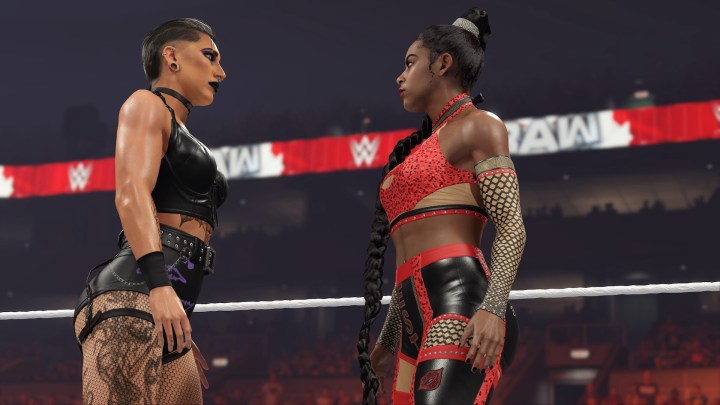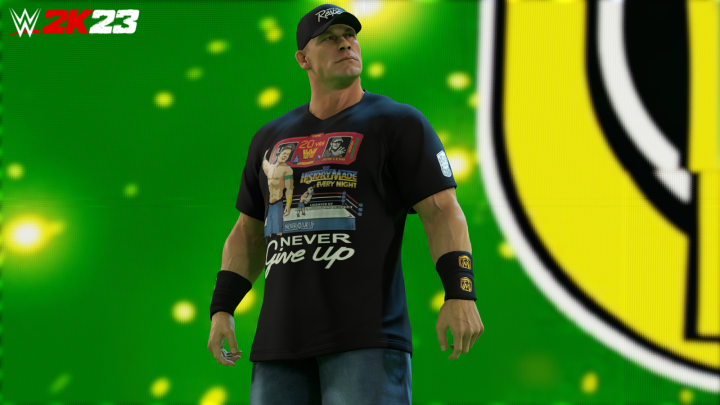I’m deep into a WarGames match when I find myself locked in a battle with the fearsome Rhea Ripley. Due to the unique structure of the match, where two rings sit side by side surrounded by a cage, I’ve broken off into a one-on-one match on the right side of the cage. I’m so locked into the action that I don’t notice that my teammates are getting demolished on the other side, with Charlotte Flair and Bayley having constructed an ungodly mess of tables. I sprint across the ring, hop into the other one, and even the odds. The sequence ends with me slamming Charlotte through her own table, giving me the kind of hero moment I’d pop for in a real wrestling match.
The WWE 2K series hinges on moments like this, letting wrestling fans live out their wildest fantasies without having to worry about tearing a pec. This year’s edition, WWE 2K23, looks to continue that streak by adding WarGames, a creative spin on its signature Showcase mode, as well as by making a whole bunch of tweaks to smooth out the series’ bumps. There’s essentially one goal here: eliminate any remaining ring rust from the disastrous WWE 2K20.
Based on a few hours of hands-on time, the 2K team seems poised to accomplish that goal. While some of my key gripes from the 2022 edition are still present, many of this year’s more nuanced updates go a long way toward improving the psychology of its matches. That makes for a strong foundation that I’m hoping its wealth of modes can better capitalize on.
Core changes
The basic controls and flow of a match are largely unchanged from 2K22 — at least on a surface level. I’m still alternating light and heavy strikes, grappling my opponent, and mashing my way into big spots. The more one-on-one matches I played, though, the more I began to see all the little adjustments stacking up.
Take reversals, for instance. In 2K22, reversals were fairly frequent. Players would get a lengthy amount of time to hit the reversal button, making matches play out like a constant seesaw. That made for some visually exciting moments, but didn’t really simulate wrestling too well. It always felt pretty easy to get out of danger and turn something around. That window feels much shorter in 2K23, making reversals a little more special when they do happen. I’m encouraged to really pay attention and sharpen my reaction time as a result, adding more tension to a match.

Perhaps the smallest-on-paper but biggest-in-practice tweak comes to the pin system. This year, kicking out of a pinfall attempt isn’t just a matter of mashing buttons. Instead, the pinned player needs to complete a quick minigame where they flick the right stick up when a cursor lines up with a moving green box. The more damaged they are, the smaller that box becomes. On a fundamental level, it just makes sense. Flicking a stick upwards more closely resembles the physicality of a wrestler wrenching their shoulder off the mat. But more than that, the new system better communicates the drama of that moment. When I kick out of a razor-thin green line, I actually feel like a wrestler narrowly avoiding a close two-and-a-half count.
Other changes are more subtle, like the ability to perform in-ring springboard maneuvers or shift to its AI. The latter could wind up having a major impact, as poor AI made tag-team matches a bit unbearable in the 2022 edition. Members of the development team tell me that tag-team AI should be better in this edition, as teammates won’t break up pinfall attempts as frequently as they used to. That drills down even more specifically to individual wrestlers. For instance, you won’t see the giant Omos scaling the turnbuckle as frequently, with the AI’s behavior more closely sticking to that of the real-life wrestler.
If you weren’t won over by the controls and flow of a match in 2K22, this version likely won’t convert you with its subtleties. For fans, though, the improvements here should make for a smoother foundation that rewards those who really lock in and pay attention to a match. After all, we all know a wrestler is doomed when they start getting too cocky in the ring.
Ready for war
I got to try a handful of one-on-one matches and a Royal Rumble (which accurately predicted that Cody Rhodes would win hours before the actual Rumble), but WarGames was a focus of my demo event. The unique match type throws two teams of three or four in that caged, two-ring structure I mentioned earlier. The match begins as a one-on-one affair, with more teammates entering the ring every few minutes. New entrants can even toss tables and chairs into the cage before entering. The match only “begins” once all members of each team have entered the ring.
WarGames is an inherently chaotic match type in real life and that scared the 2K team when developing the mode. What’s fun on TV isn’t always fun in games — something that I especially notice in some of 2K22’s more prop-heavy matches. For instance, WarGames is inherently a lopsided setup early on, as the staggered nature of entrants means that a team will find itself in two-on-one or three-on-two situations. That was a bit frustrating in the early stages of some of my matches, but that’s the intent too. The 2K team notes that part of the real match type’s drama comes from those shifting power dynamics, and it wanted to honor them rather than rebalance them to make the mode feel “fair” the whole way through.

What surprised me most during my demo is how well WarGames actually works as a mode. In my 2K22 review, I noted that matches tend to get worse the more wrestlers that are involved. It turns into a mosh pit as AI opponents crammed in a small ring swing at each other without any sense of pace or structure. WarGames actually solves that problem since the ring itself is twice as big. It means that wrestlers are more spread out and can break out into smaller encounters rather than everyone slugging it out in the center of the ring. The 2K team even notes that computer-controlled characters will instinctively move to the other ring when one is too crowded to better balance the match.
All of that is how I arrived at that hero moment I mentioned initially. With the ring split into different sections, it’s easier to have multiple narratives happening at once rather than having them all bleed together. As a solo player, I can also seamlessly switch between teammates at will if I want to jump around from brawl to brawl. All of that makes for a multi-superstar match that’s much easier to parse, even if the outside cage obscures a bit of the action.
I did still experience some odd AI behavior here, which makes me think that there’s some work left to do. In one match, I had Kurt Angle on the ropes as I set him up for Xavier Woods’ finisher. My teammate, a computer-controlled Bron Breakker, had other ideas though. True to his name, he kept attacking Angle every time I set him up for a finisher, preventing me from getting my glory moment. On the flip side, though, I watched Becky Lynch and Rhea Ripley pull off an incredible AI feat as each climbed to the top of the cage and flattened me with two perfectly timed cross-bodies one after another. Moments like that have me eager to get back in the cage and see how chaotic it can really get.
You can’t see me
This year’s cover star is none other than John Cena, which means that the Hollywood actor is the star of this year’s Showcase mode, which pushed the team to think creatively. Previous showcase modes have players assuming the role of a wrestler, like Rey Mysterio, and playing through a list of career-defining matches in a documentary framework. Cena’s Showcase is much different though; instead, players take control of the rivals that actually beat him.
That twist brings some pros and cons. On the positive side, it makes the campaign much more diverse and exciting. Rather than playing as one wrestler with the same move set match to match, they get to learn how different wrestlers play. In my first match, I took on the role of Rob Van Dam and got to experiment with his high-flying style. Next, I was in Kurt Angle’s shoes during Cena’s “ruthless aggression debut,” hitting powerful suplexes and submissions. Unfortunately, it doesn’t seem like you’ll get to play as John Stewart spoiling Cena’s 2015 Summerslam loss against Seth Rollins.

Though I love swapping between wrestlers much more than sticking to one, it does compound Showcase’s biggest issue. The mode has players recreating actual sequences from its historic matches by giving players certain objectives. Like in 2K22, however, players only get a general text prompt in the corner of the screen telling them what move to hit. If you don’t know how to perform an Irish whip, you’ll need to pause the game and look it up. One objective told me to knock Cena against the north or south barricades, but those directions aren’t really part of the game’s language. I’d struggle with it for a bit, assuming north was relative to the ramp, only for a dev to point out that the directions were built around the camera-side of the ring.
In a regular Showcase mode, this gets easier by playing. The more you get to know Rey Mysterio’s move set, the more you can execute spots without being told how to do them. Here, though, you’re constantly switching between wrestlers with different moves. When it tells me to execute a corkscrew knee strike as Rob Van Dam, I have no idea what that means without popping into the menu. I imagine that will mean I’m in menus even more, breaking up what’s supposed to be a fluid mode that weaves together gameplay and real match footage.
That quirk is emblematic of an ongoing task for the 2K team. It’s a series of refinements, as the developers solve new problems with each entry — something that’s going to be a taller task with the series returning to an annualized release cadence. This year’s edition seems to address some of 2022’s more core issues, nailing down the psychology of a match and tweaking AI. Modes like MyGM are set to expand too, further building out some great ideas that were left a little thin last year. And perhaps most importantly for this series, I didn’t encounter any bugs during my playthrough.
Like any great wrestler, I still feel there’s a little room for growth in WWE 2K23. However, this year’s edition is currently walking with the confidence of a champion. Even the fact that it’s being demoed so far ahead of its release speaks volumes to 2K Games’ perception of it compared to previous entries. If it keeps working out, the series could rise to Super Cena soon enough.
WWE 2K23 launches on March 17 for PlayStation 4, PS5, Xbox One, Xbox Series X/S, and PC.



